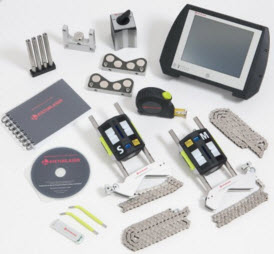OASIS metrology engineers use laser trackers to quickly and accurately measure the 3D coordinates of machines and components
Here at OASIS, we often receive requests for “laser alignment” services. However, this term can apply to several similar, but distinct solutions. In this post, we provide a brief overview of the various tools and technologies that can fall under the category of laser alignment. In future posts, we will delve further into laser alignment tools and describe the applications where each solution excels.
In our field of industrial precision alignment, laser alignment is a generic term used to describe the process of aligning machines using lasers. This term is much like the one used to describe machinery alignment performed using optical instruments, often called optical alignment. Laser alignment can be performed using alignment lasers or other portable coordinate measuring machines such as laser trackers. Laser trackers use laser technology to measure 3-dimensional coordinates quickly and with a high degree of accuracy. The alignment data gathered can be converted to geometrical points, planes, spheres or cylinders using a 3D metrology software solution. These features can then be referenced to defined datum for position, form, parallelism, perpendicularity and more. In the hands of skilled metrology engineers, portable 3D metrology tools are an innovative solution for the laser alignment of industrial machines.

OASIS technicians often use an alignment laser such as this Fixturlaser, for shaft alignment
Alignment lasers are specialized laser instruments specifically designed to perform industrial alignment tasks. There are many brands of alignment laser systems for all types of industrial applications including shaft alignment, and belt and pulley alignment just to name a few. Typically line or point lasers can be used for planar, rectilinear or perpendicular alignments of machine components. Alignment lasers are most often sold loaded with the programs required to perform their various capabilities. Alignment lasers do not however, provide true 3D coordinates or points, but rather provide the relative alignment of their components (emitter and receiver). Learn more about the causes of machine alignment.
The process of aligning lasers can also fall into the category of laser alignment. In this case, the intended meaning is the act of making alignment adjustments to specialized laser equipment or positioning lasers within an industrial process. Larger equipment or modular laser systems require a certain level of alignment in order to function as intended.
This post covers only a small part of the world of laser alignment. Please check back for more on the various tools, technologies and applications that can fall under the category of “Laser Alignment”. If you would like to discuss your equipment alignment needs and would like a site visit to your facility, please contact the OASIS Service Center nearest you.

